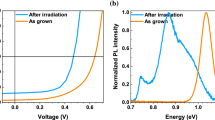Abstract.
We investigate the degradation of ZnO/CdS/ Cu(In,Ga)Se2 heterojunction solar cells for space applications and the defect generation in polycrystalline Cu(In,Ga)Se2 thin films by irradiation with 1-MeV electrons with fluences φe up to φe=5×1018 cm-2. Notable degradation of the solar cell performance starts at fluences of φe=1017 cm-2 where the open circuit voltage decreases by about 5% while short circuit current and fill factor remain essentially unaffected. Thus, Cu(In,Ga)Se2 solar cells withstand electron fluences which are higher by one order of magnitude or more when compared to other technologies. A model describes the absolute open circuit voltage loss considering the increase of space charge recombination by electron irradiation-induced defects. Defect analysis by admittance spectroscopy shows that acceptor defects with an energy distance of approximately 300 meV from the valence band are generated at a rate γ=0.017 (±0.01) cm-1.
Similar content being viewed by others
Author information
Authors and Affiliations
Additional information
Received: 17 February 2000 / Accepted: 28 March 2000 / Published online: 11 May 2000
Rights and permissions
About this article
Cite this article
Jasenek, A., Rau, U., Hahn, T. et al. Defect generation in polycrystalline Cu(In,Ga)Se2 by high-energy electron irradiation . Appl Phys A 70, 677–680 (2000). https://doi.org/10.1007/PL00021081
Issue Date:
DOI: https://doi.org/10.1007/PL00021081




